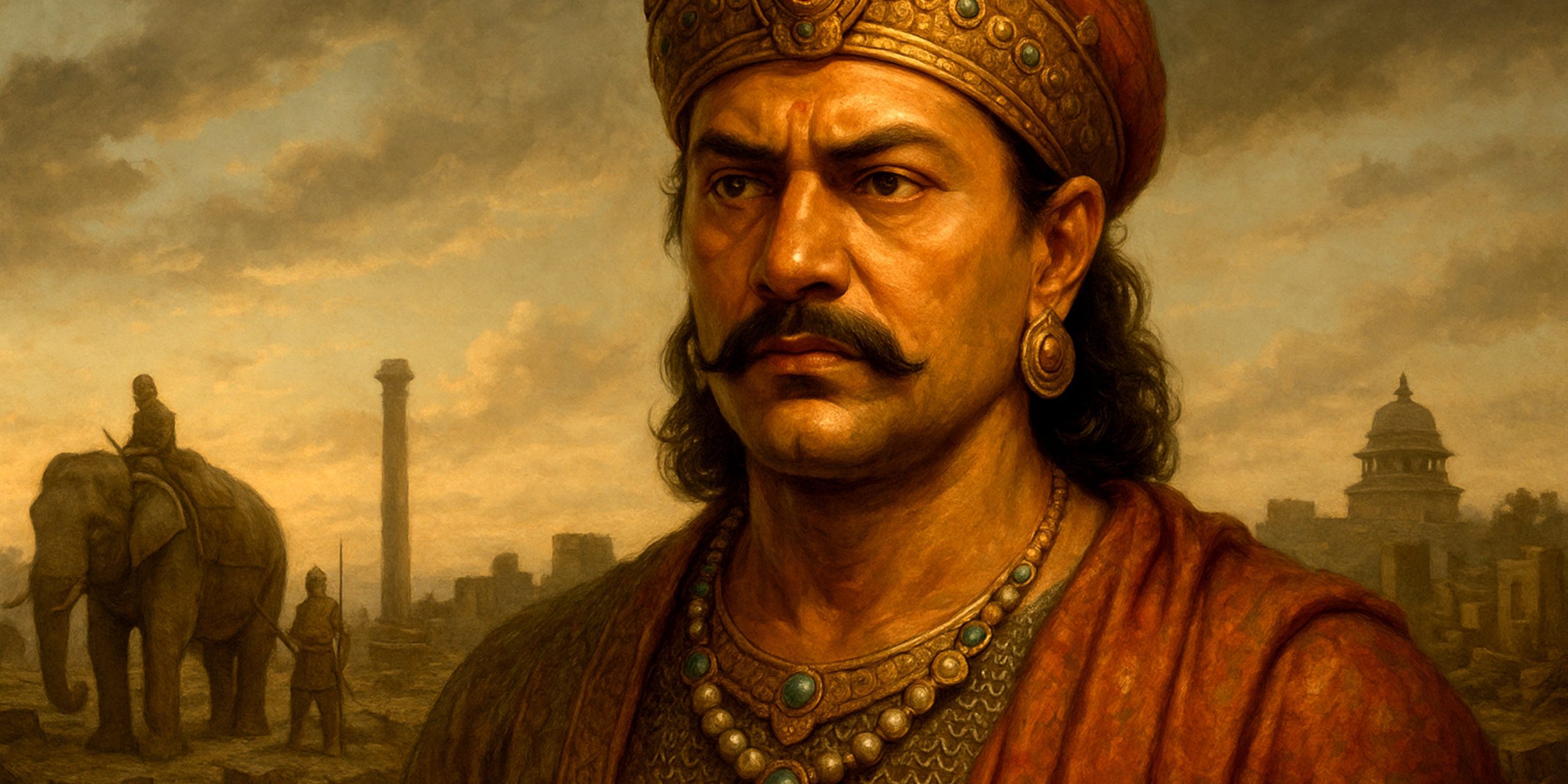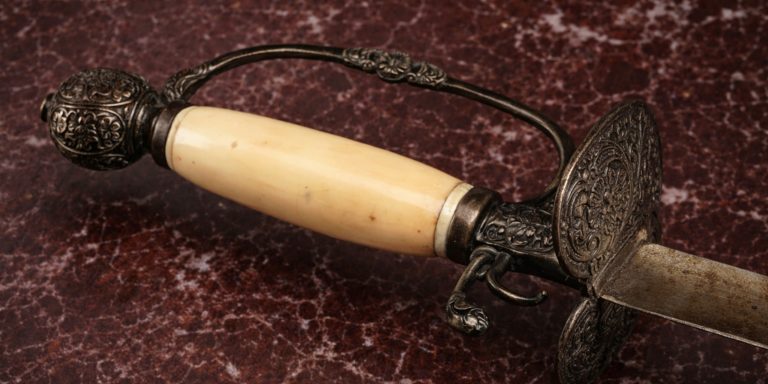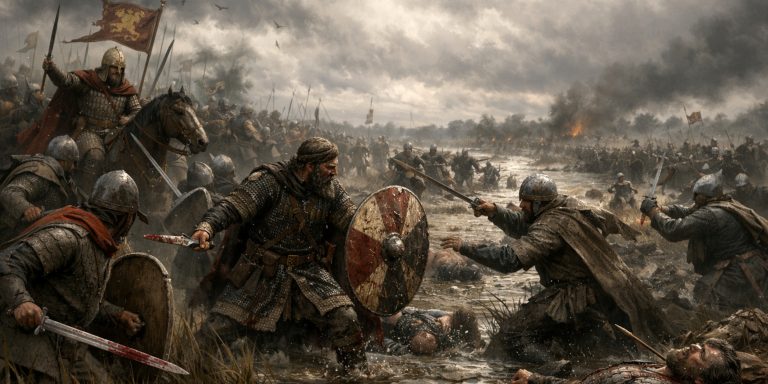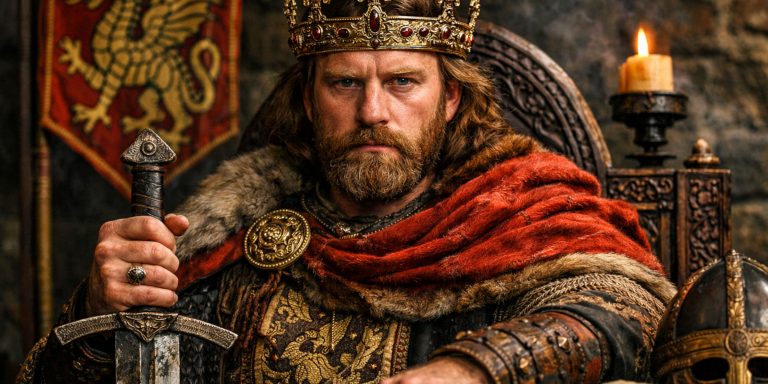
Few rulers in history have undergone a transformation as profound as Ashoka, the Mauryan emperor who went from ruthless conqueror to champion of peace. Known to later generations as Ashoka the Great, his reign in the 3rd century BCE represents one of the most fascinating intersections of power, philosophy, and statecraft in the ancient world.
What we know of Ashoka comes from a mix of stone inscriptions, Buddhist chronicles, and archaeological discoveries that continue to expand our understanding of his empire. He remains, in many ways, both familiar and elusive: a man who wielded immense military might, then renounced violence in the name of moral awakening.
Arms and Armour
Before his famed conversion to Buddhism, Ashoka commanded one of the most formidable armies of the ancient world. The Mauryan military machine was a sophisticated force, well supplied and meticulously organised.
Key elements of Ashoka’s military arsenal likely included:
- Infantry: Soldiers equipped with spears, bows, and straight-edged swords, often supported by large shields made of wood or hide.
- Cavalry: Mounted units carrying lances and short swords for close combat.
- War elephants: The hallmark of Mauryan warfare. These towering beasts were armoured with metal or leather plates and used to break enemy lines.
- Chariots: Multi-purpose vehicles used for command visibility and speed on open terrain.
Mauryan armour was typically made from quilted cloth, leather, or bronze scales sewn onto linen. It was functional rather than decorative. A few surviving reliefs and carvings, such as those from Sanchi and Bharhut, hint at soldiers in belted tunics with layered protection and short helmets resembling caps.
As a military leader, Ashoka inherited and refined the Mauryan model, maintaining a vast standing army that was both costly and effective. The scale of his campaigns suggests sophisticated logistics and a clear understanding of both strategy and morale, traits often overlooked in favour of his later moral reputation.
Battles and Military Acumen
The defining battle of Ashoka’s life was the Battle of Kalinga, fought around 261 BCE. The campaign was brutal. Kalinga, situated along the eastern coast of India (modern-day Odisha), resisted Mauryan control fiercely. The war was costly in every sense, tens of thousands were killed, countless others deported, and the region left devastated.
Ashoka’s own inscriptions later describe his horror at the aftermath, suggesting that the victory felt hollow. The Rock Edict XIII is particularly revealing, recording that “the slaughter, death and deportation of people is deeply regretted by the beloved of the gods.”
This was not the voice of a general gloating over conquest, but of a ruler shaken by the price of his ambition.
Still, the battle showed his organisational brilliance. The Mauryan army’s discipline, supply routes, and tactical coordination were unrivalled in India at the time. He successfully integrated multiple regional forces, used elephants to devastating effect, and ensured his campaign had clear logistical support across vast terrain.
After Kalinga, Ashoka channelled his administrative precision into something entirely different: spreading the principles of Dhamma, or righteous living. His empire, once maintained by the sword, became a laboratory for moral governance.
The Empire of Stone: Archaeology and Artifacts
One of the most tangible legacies of Ashoka’s reign lies not in weapons but in stone. His network of edicts, carved into pillars and rocks across India, remains one of the earliest and most ambitious state communication systems in history.
These inscriptions, written in Prakrit and Greek, appear from Afghanistan to southern India and reveal a ruler deeply concerned with ethical conduct, compassion, and justice.
Notable artefacts and sites linked to Ashoka include:
- The Ashokan Pillars: Tall, polished sandstone columns topped with animal capitals, most famously the Lion Capital of Sarnath, now India’s national emblem.
- The Great Stupa at Sanchi: A monumental Buddhist structure expanded under his patronage.
- The Edicts of Dhauli and Girnar: Among the best-preserved, describing his remorse and policies of non-violence.
- Taxila and Ujjain: Major administrative and cultural centres during his reign, rich with Mauryan artefacts and urban ruins.
Recent archaeological work has revealed Ashokan-era relics in Lumbini (modern Nepal), suggesting that he not only promoted pilgrimage sites but physically marked them with inscriptions. The discovery of his pillar there confirms both the scale and sincerity of his religious devotion.
Latest Archaeological Findings
Archaeology continues to reshape our understanding of Ashoka’s reign. In recent decades, excavations at Dhauli and Sannati have uncovered new fragments of edicts that broaden the known range of his empire.
At Rupnath and Maski, early decipherment of his inscriptions by British archaeologists like James Prinsep in the 19th century first identified “Devanampiya Piyadasi” as Ashoka himself, a reminder that even his identity was lost for centuries until modern archaeology restored it.
Contemporary research using digital mapping and ground-penetrating radar has revealed new urban layouts in Pataliputra (modern Patna), the Mauryan capital, including wooden palisades, stone ramparts, and the remains of vast administrative halls. These findings reinforce the view of a state that was not just militarily powerful but administratively sophisticated.
Legacy
Ashoka’s transformation from conqueror to moralist remains one of history’s most extraordinary shifts. He did not abandon power, but redefined it. His empire became a moral project, aimed at governing through example rather than fear.
His policies influenced Buddhist thought across Asia, spreading from Sri Lanka to Central Asia and beyond. Even today, the Dhamma Chakra (Wheel of Law) on India’s national flag originates from Ashokan symbolism.
As a historian, I find Ashoka’s contradictions the most compelling part of his legacy. He reminds us that power and conscience are rarely simple companions. His edicts still whisper across time, etched into stone, asking us to consider whether greatness lies in conquest, or in remorse.
Where to See Ashokan Artefacts Today
For those who wish to stand before his legacy, here are some of the best sites and museums:
| Location | Artefact / Site | Highlights |
|---|---|---|
| Sarnath Museum, Uttar Pradesh | Lion Capital of Ashoka | Finely carved sandstone lions, symbol of Indian state emblem |
| Sanchi, Madhya Pradesh | Great Stupa and railings | Early Buddhist art and Ashokan architecture |
| National Museum, New Delhi | Mauryan artefacts | Sculptures, seals, and relics from Ashokan sites |
| Lumbini, Nepal | Ashokan Pillar | Inscribed pillar marking the birthplace of Buddha |
| Dhauli, Odisha | Rock Edicts | Inscriptions expressing remorse after the Kalinga War |
| Taxila Museum, Pakistan | Mauryan remains | Early Buddhist art and urban relics from Ashokan administration |
The Seven Swords Takeaway
Ashoka’s reign is one of those rare historical episodes that resist simplification. He was at once a warrior, reformer, and philosopher-king. His inscriptions remain oddly personal for such an ancient age, moments of vulnerability carved into stone.
It is tempting to see him as an idealist out of time, but perhaps it is more accurate to see him as the first ruler to understand that the weight of empire is not measured in victories, but in regret.



